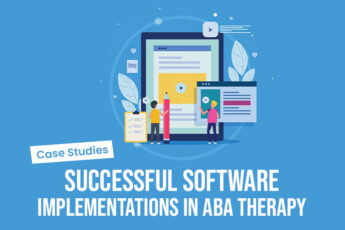The world of ABA therapy is constantly evolving, pushing providers to innovate and find ways to enhance their services, streamline operations, and ultimately, improve client outcomes. One powerful tool in this evolution is custom software development.
While traditional, off-the-shelf software may fall short of meeting the unique demands of ABA therapy, custom solutions offer a tailored approach. This allows providers to address specific needs and challenges, creating software that perfectly aligns with their workflows, data requirements, and client-centred philosophy.
Let’s delve deeper into why custom software is a game-changer for ABA therapy providers…
Enhanced Data Management and Reporting:
Custom software empowers providers to manage vast amounts of client data effectively. By integrating with existing systems and building bespoke data entry forms, it simplifies the collection of essential information, including behavioral observations, intervention strategies, and progress notes. This centralized data repository enables a seamless transition between different stages of therapy, facilitating comprehensive assessments and individualized treatment plans.
Streamlined Communication and Collaboration:
ABA therapy often involves collaboration between various professionals, including therapists, supervisors, and parents. Custom software fosters seamless communication by providing secure platforms for sharing client data, scheduling appointments, and exchanging progress updates. This fosters a collaborative environment, ensuring everyone is on the same page and working towards shared goals.
Improved Client Engagement and Motivation:
Interactive features within custom software can enhance client engagement and motivation. Visual aids, gamification elements, and personalized progress trackers can transform data into engaging experiences, making therapy more appealing and reinforcing positive behaviours.
Personalised Treatment Plans and Data-Driven Insights:
Custom software facilitates the creation of dynamic treatment plans tailored to individual clients. Data analysis reveals client progress, enabling providers to adjust treatment for optimal outcomes. This data-driven approach ensures that therapy remains individualized and responsive to each client’s unique needs.
Increased Efficiency and Productivity:
By automating repetitive tasks, such as scheduling, billing, and data entry, custom software frees up valuable time for therapists to focus on direct client interaction. This leads to increased efficiency, productivity, and a more fulfilling experience for both therapists and clients.
Transitioning to a New Era of ABA Therapy:
As ABA therapy evolves, custom software solutions are becoming increasingly crucial in supporting providers’ transition to a new era of innovation and efficiency. This transition, in turn, allows providers to harness the power of technology. Consequently, they can embrace data-driven decision-making, thereby streamlining workflows and ultimately enhancing the quality of care they deliver. In this way, custom software acts as a catalyst for positive change within ABA therapy.
Benefits of Custom Software Solutions:
- Tailored to Specific Needs: Custom software aligns perfectly with the unique workflows, data requirements, and client-centered approach of each practice.
- Enhanced Data Management: Streamlines data collection, storage, and analysis, providing valuable insights for treatment planning and progress monitoring.
- Seamless Communication: Facilitates collaboration among therapists, supervisors, and parents, ensuring everyone is on the same page.
- Increased Client Engagement: Interactive features, personalized progress trackers, and gamification elements enhance client motivation.
- Improved Efficiency and Productivity: Automates repetitive tasks, allowing therapists to focus on direct client interaction.
Conclusion: DIBS empower ABA therapy providers to navigate the complexities of their field with greater confidence and efficiency. As a result, technology empowers providers to deliver better care, improving client outcomes and creating a more positive experience. Furthermore, the transition to custom software marks a significant step toward a future where technology empowers ABA therapy to reach its full potential.







Leave a Comment